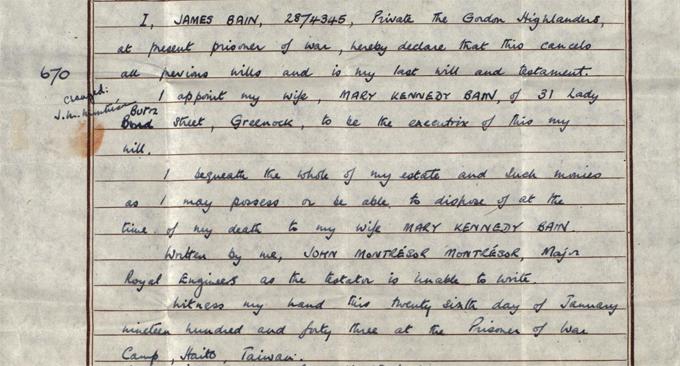Eric Sutherland Lomax was born on 30th May 1919 at 11 Bedford Terrace, Portobello, the son of John Lomax, Civil Service clerk, and his wife Elizabeth Sutherland.

Detail from Eric Lomax's birth entry
Crown copyright, National Records of Scotland (NRS), Statutory Register of Births, 1919, 685/7 no. 133
His father worked in the General Post Office (GPO), opposite General Register House, the building where one of the Scotland's People search rooms is based today. Eric also worked there before the war, and very briefly after returning to Scotland and being demobilised.
In 1939 Eric joined the Royal Corps of Signals, before the war broke out. He was commissioned as a 2nd Lieutenant in December 1940 and was one of thousands of soldiers who surrendered to the Japanese in Singapore in February 1942.
The Japanese forced approximately 200,000 Asian conscripts and over 60,000 Allied Prisoners of War (POWs) to construct the Burma Railway. Eric was one of the 30,000 British POWs set to work on the line which became known as the 'Death Railway'; 27% of Allied POWs died or were killed in Japanese custody compared to a 4% death rate in German camps (source: Encyclopaedia Britannica).
Private James Bain, the Gordon Highlanders, was a Scottish soldier who died in a Japanese POW camp in Haito, Taiwan, in April 1943. James left his estate and monies to his wife Mary Kennedy Bain. The will was written on his behalf, as he was too ill to write it himself, and bears the official stamps and finger prints of the Japanese and British officers who witnessed it.
Prisoners in the Haito Camp worked in cane fields and in the nearby sugar factory. Men often died of sun-stroke or were beaten if the daily work targets were not met. Food was scarce and disease spread easily, including malaria, which killed James. His remains were scattered over Hong Kong in 1946.

Detail of the Will of Private James Bain
NRS, Soldiers' and Airmen's Wills, SC70/8/1334/512.
An image of the will and transcript can be seen on the Scottish Archives for Schools resource Leaving it all Behind.
As in the camp in Haito, existence for the men building the Burma Railway comprised sickness, starvation and maltreatment. During his time as a POW, Eric and a group of fellow prisoners were found hiding a radio receiver made from scrap parts; they were tortured, beaten and interrogated for this act. Eric survived this physically, but he was left with haunting and traumatic memories which he couldn't escape from on his return to Scotland.
On 20 November 1945, aged 26 years old, he married Agnes Scott Dickson, a sorting clerk and telegraphist who also worked in the GPO. The wedding entry described Eric's occupation as a Clerical Officer, Post Office Telephones (Lt, Royal Signals). The couple had met through the Charlotte Baptist Chapel in Edinburgh before Eric was sent overseas, and there were strong religious and social expectations that they would marry should he return from the war. They spent time in Africa as part of Eric's job in the Colonial Office before returning to Scotland where he was a lecturer at Strathclyde University.
Throughout this period in his life, Eric found it almost impossible to communicate the daily haunting memories of his trauma with his wife and family. This led to great tension and difficulties in their relationship. They divorced in 1982.
Eric married his second wife, Patti, the following year. A turning point for Eric came when a fellow ex-POW sent Eric a newspaper cutting featuring Takashi Nagase the translator who had taunted him throughout his beatings and whose voice had never left Eric's mind since the war. Takashi was looking for reconciliation with allied prisoners.
At the end of the 1980s, Eric and Takashi met. Takashi carried a heavy weight of guilt and had disavowed the brutality of his compatriots treatment of their prisoners. The meeting helped Eric to exchange his feelings of vengeance for a wish for reconciliation. As Eric stated on the website The Forgiveness Project, 'I had intense hatred for the Japanese, and was always looking for ways and means to do them down. In my mind I often thought of my hateful interrogator. I wanted to drown him, cage him and beat him as he had done to me.'
Following the meeting, Eric said he felt I'd come to some kind of peace and resolution. Forgiveness is possible when someone is ready to accept forgiveness. Sometime the hating has to stop.
Both men had been greatly damaged by the war and understood each other's experiences. Over time they both became friends and, despite Eric being unable to travel very often due to his age, they exchanged telephone calls and Christmas cards.
In 1995, Eric's book 'The Railway Man' was published and became one of the landmark books of the 1990s, describing the prisoners experiences, traumas and, in many cases, their deaths in a Japanese labour camp. The book was later adapted into a film starring Colin Firth and Nicole Kidman. It was released in 2013, the year after Eric died in Berwick-on-Tweed.
Further reading
You can discover more about Scottish soldiers' and airmen's wills in our record guide.
For information on British and Commonwealth prisoners of war 1939-1945, see The National Archives research guide.
The Children (& Families) of the Far East Prisoners of War, (COFEPOW), is a charity dedicated to perpetuating the memory of the Far East Prisoners of War and features news, articles and a research database which may be helpful for those wishing to trace the stories of POWs.